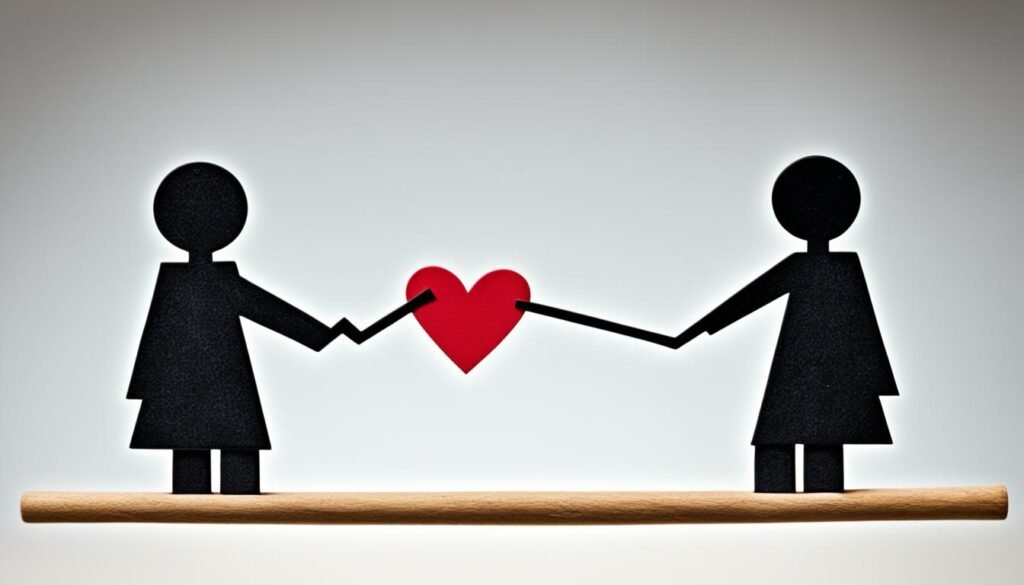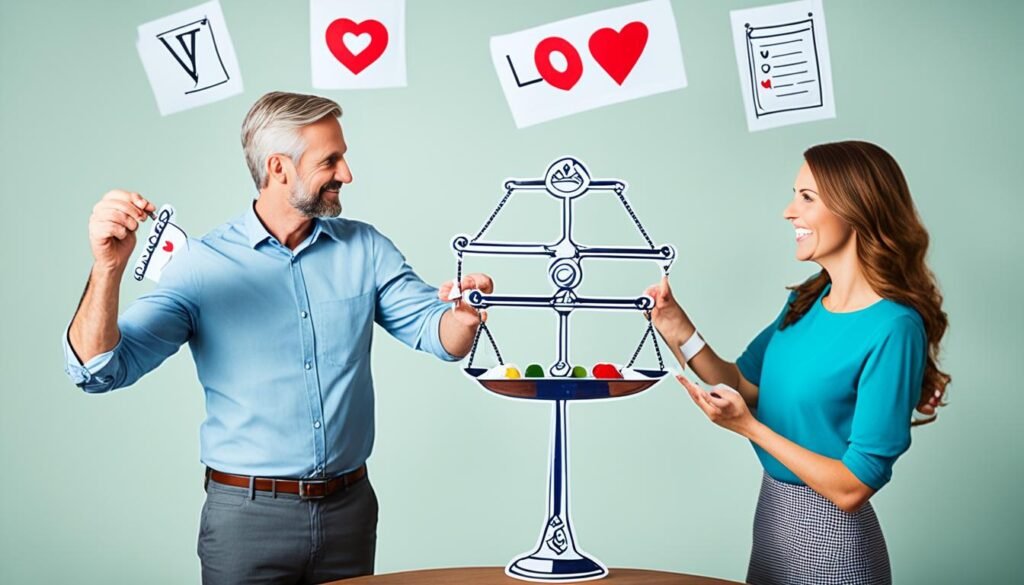
Have you ever found yourself questioning the dynamics of love in a relationship? Wondering who should love more? We’ve all been there, tangled in the beautiful complexities of love and trying to find our place within it. It’s a topic that evokes a myriad of emotions, from excitement and joy to uncertainty and even fear.
When it comes to relationships, finding the right balance of love is crucial for a harmonious connection. Understanding the role of affection, emotional investment, and equitable love sharing is key to fostering a lasting bond filled with love and happiness.
In this article, we will explore the intricacies of relationship dynamics and delve into the controversial question of who should love more. By examining the various perspectives and considering the importance of mutual emotional contributions, we aim to shed light on this intriguing aspect of love.
Join us on this journey as we navigate the realms of love distribution, relationship harmony, and the significance of each partner’s emotional investment. Together, we will uncover the secrets to a balanced and fulfilling relationship that stands the test of time.
Key Takeaways:
- The dynamics of love in a relationship can be complex and multifaceted.
- Achieving a balance of love is crucial for the harmony and happiness of the partnership.
- Understanding the role of affection, emotional investment, and equitable love sharing is key.
- Mutual emotional contributions are essential for building a lasting and fulfilling bond.
- Exploring the question of who should love more can shed light on relationship dynamics and expectations.
Defining Love in a Heterosexual Relationship
Love in a heterosexual relationship is a beautiful and intricate emotion that encompasses various elements. Attraction forms the foundation of love, drawing two individuals together in a magnetic pull. It is the initial spark that ignites the flame of a romantic connection.
Companionship is another vital aspect of love in a heterosexual relationship. It involves being each other’s partners in life, sharing experiences, and building a life together. Companionship brings a sense of comfort and security, knowing that you have someone by your side through both the joys and challenges of life.
Intimacy, both emotional and physical, plays a significant role in love. Emotional intimacy involves sharing your deepest thoughts, fears, and dreams with your partner, creating a deep emotional bond. Physical intimacy, on the other hand, encompasses gestures of affection, such as cuddling, holding hands, and intimate moments that express desire and passion.
Loyalty is a fundamental pillar of love in a heterosexual relationship. It signifies unwavering commitment and fidelity to one another. Loyalty involves standing by your partner through thick and thin, supporting their dreams and aspirations, and being each other’s fiercest allies and advocates.
An emotional connection is at the core of love in a heterosexual relationship. It is the intricate web of emotions that binds two individuals together. It involves understanding and resonating with each other’s feelings, offering comfort, and being a safe haven for one another.
While these aspects define love in a heterosexual relationship, it is important to note that the expression and interpretation of love may vary from person to person. It can evolve and change over time as the relationship grows and matures. Additionally, societal norms and expectations may influence the understanding of love in a heterosexual relationship.
Now, let’s dive deeper into the impact of traditional gender roles and expectations in relationships. But before we explore that, take a moment to reflect on the beauty of love in a heterosexual relationship.
Continue reading to understand the influence of traditional gender roles and expectations in relationships.
Traditional Gender Roles and Expectations in Relationships
Throughout history, traditional gender roles have played a significant role in shaping expectations within relationships. Men were often expected to assume the roles of providers and protectors, while women were assigned the roles of caretakers and nurturing figures. These predefined gender roles have influenced societal expectations and have had a profound impact on the dynamics of romantic relationships.

Over time, these traditional gender roles have evolved and changed, but remnants of these expectations still persist in society. While progress has been made toward dismantling rigid gender norms and expectations, there is still work to be done to achieve true gender equality in relationships.
It is essential to acknowledge that love and care should not be gendered. Every relationship should be defined by the unique needs and expectations of the individuals involved. Partners should have the freedom to express their emotions, fulfill their desires, and contribute to the relationship in ways that feel authentic to them, rather than conforming to outdated gender stereotypes.
Societal expectations surrounding gender roles can create limitations and place unnecessary pressure on individuals. Breaking free from these constraints allows for a more inclusive and fulfilling relationship where both partners have the freedom to explore their own identities and roles.
It is vital to remember that gender roles are socially constructed, and they can vary across cultures and time periods. Challenging traditional gender roles not only fosters gender equality but also allows for greater individual expression, personal growth, and shared decision-making within a relationship.
The Debate: Loving Equally vs. Loving More
The debate surrounding whether one partner should love more than the other in a relationship is a subjective matter. Some argue that loving more creates a sense of security for the other partner, while others believe that love should be equal. It is an ongoing discussion that highlights the complexities of relationships and the power dynamics within them.
When one partner loves more, there is a perceived sense of security that can stem from knowing that their affection is reciprocated and that they have a greater emotional investment in the relationship. This sense of security can provide a stable foundation for the relationship to thrive. However, it is important to note that the power dynamic within the relationship can become imbalanced if one partner consistently loves more than the other.
Resentment may arise when there is an inequality in the amount of love given by each partner. The partner who loves more may feel unappreciated or taken for granted, resulting in dissatisfaction within the relationship. It is essential to maintain a sense of balance and ensure that both partners are actively contributing to the love and care within the relationship.
Ultimately, the goal should be to have a balanced and mutually fulfilling relationship. This involves loving each other equally and nurturing a sense of security and trust. Communication, understanding, and compromise play vital roles in achieving this equilibrium. Both partners should have an equal say, and their emotional needs should be acknowledged and met.

Importance of Satisfaction
Satisfaction plays a significant role in maintaining a healthy and thriving relationship. It is important for both partners to feel fulfilled and content in their love for each other. When love is distributed equally, it fosters a sense of satisfaction and prevents one partner from feeling overwhelmed or neglected.
Sense of Security and Power Dynamic
When one partner loves more, there can be a power dynamic imbalance. The partner who loves less may feel empowered or in control, while the other partner may feel vulnerable or dependent. This power dynamic can impact the overall dynamics of the relationship, leading to potential conflicts or resentment.
Mutual Fulfillment
Striving for equal love distribution ensures that both partners feel valued and appreciated. It promotes a sense of unity and partnership, where each partner contributes equally to the relationship’s success. This mutual fulfillment creates a strong foundation for long-term happiness and satisfaction.
- Loving equally fosters a sense of security and stability
- An imbalanced power dynamic can lead to resentment
- Mutual fulfillment promotes long-term satisfaction and happiness
Pros of Loving a Woman More in a Relationship
When it comes to love, some may argue that loving more can have its advantages. In a relationship, a man loving a woman more can create a sense of security for her, fostering a deeper emotional connection and increasing trust and intimacy. Let’s explore some of the pros of loving a woman more:
- Prioritizing Needs: When a man loves a woman more, he is more likely to prioritize her needs. This creates a balanced dynamic where both partners feel valued and cared for.
- Increased Trust and Intimacy: A greater level of love and care can lead to increased trust and intimacy in the relationship. The woman feels secure in knowing that her partner is dedicated to her emotional well-being.
- Stronger Bond: Loving a woman more can result in a stronger bond between the couple. The commitment and effort put into the relationship can create a solid foundation for a lasting partnership.
By prioritizing a woman’s needs, loving more can help foster a balanced and harmonious relationship. Both partners can feel secure, loved, and emotionally fulfilled.

Cons of Loving a Woman More in a Relationship
While loving a woman more in a relationship can have its advantages, it’s important to acknowledge the potential drawbacks that may arise. Here, we explore some of the cons of loving more and the challenges it can present in maintaining a balanced and fulfilling partnership.
Power Dynamic and Imbalance in Responsibility
A key concern when one partner loves more in a relationship is the creation of an uneven power dynamic. This imbalance can manifest in various ways, such as decision-making authority and control over the relationship’s direction. The partner who loves more may find themselves compromising more often, leading to a sense of diminished agency and influence.
This power dynamic can also extend to an imbalance in responsibility, where the partner who loves more may shoulder a disproportionate share of household chores, emotional labor, or financial obligations. This unequal distribution of responsibilities can result in frustration and resentment, potentially straining the relationship.
Lack of Effort and Personal Growth
When one partner assumes the role of loving more, there is a risk that the other partner may not put in the same level of effort to nurture the relationship. This lack of effort can lead to a stagnant dynamic and hinder the growth and development of both individuals.
Furthermore, the partner who loves more may feel that their efforts go unnoticed or unappreciated, which can impact their self-esteem and overall satisfaction in the relationship. Without a mutual investment in personal growth, the relationship may lack the necessary fuel for long-term fulfillment.

In order to foster a healthy and balanced relationship, it is crucial to address these cons of loving more. Open and honest communication is paramount for both partners to express their needs, concerns, and desires. By actively collaborating and sharing responsibilities, couples can establish a more equitable power dynamic and promote shared growth and fulfillment.
The Importance of Balance in Relationships
Balance is crucial in any relationship for long-term sustainability. When two people come together, it should be viewed as a partnership where both partners contribute equally to the well-being of the relationship. This requires open communication, mutual respect, and a willingness to compromise.
Partners should strive to maintain a sense of balance in their relationship by recognizing and valuing each other’s contributions. This includes emotional support, decision-making, and sharing responsibilities. When both partners actively participate and make mutual efforts, it fosters a sense of equality and harmony.
Communication is a key component in establishing and maintaining balance. Effective communication allows partners to express their thoughts, feelings, and needs openly. It helps to resolve conflicts, clarify expectations, and build a strong foundation of understanding and trust.
Mutual respect is essential in creating balance. Each partner should acknowledge and respect each other’s individuality, opinions, and boundaries. This fosters an environment where both partners feel valued and appreciated, leading to a healthier and more fulfilling relationship.
Compromise is a fundamental aspect of maintaining balance in relationships. It involves finding middle ground and making decisions that benefit both partners. Compromise requires flexibility, understanding, and a willingness to prioritize the well-being of the relationship over individual preferences.
It is important to note that balance in relationships does not imply an exact 50/50 split of responsibilities or emotions. Each partner brings their own unique strengths and interests, and balance should be achieved by understanding and accommodating these differences. The goal is to create a dynamic where each partner feels supported, understood, and respected.
Overall, balance in relationships is essential for long-term happiness and fulfillment. It requires partnership, mutual respect, communication, and compromise. When these elements are present, relationships can thrive, allowing both partners to grow and evolve together.

Communication as the Key to Successful Relationships
Effective communication is the cornerstone of any successful relationship. It is essential for partners to engage in open and honest conversations, expressing their needs and actively listening to each other. Communication builds a strong foundation of trust and mutual understanding, fostering a deep connection between partners.
Regular check-ins and discussions about the relationship are crucial in preventing misunderstandings and addressing any issues that may arise. These conversations provide an opportunity to share feelings, concerns, and aspirations, allowing both partners to align their expectations and work towards common goals.
By actively expressing needs and desires, partners can create an environment of openness and vulnerability, enabling them to fulfill each other’s emotional needs. This open dialogue helps to build a deeper sense of mutual understanding and empathy, strengthening the bond between partners.
Active Listening for Deeper Connection
Active listening plays a vital role in effective communication. It involves giving full attention to what your partner is saying, without interrupting or judging. By actively listening, you show respect and empathy, creating a safe space for your partner to express themselves.
When engaging in conversations, be present and focus on understanding your partner’s perspective rather than formulating your response. This level of attentiveness not only validates your partner’s feelings but also fosters a deeper connection and promotes mutual understanding.
Regular Check-ins for Relationship Growth
Regular check-ins provide an opportunity to assess the health of the relationship and address any concerns or areas for improvement. These discussions can be scheduled or impromptu, but they should be approached with openness and a genuine desire to understand and support each other.
During check-ins, partners can openly discuss their feelings, desires, and any changes or challenges they are experiencing. These conversations enable both partners to continuously adapt and grow together, fostering a relationship that evolves over time.

Creating a culture of open and honest communication requires effort from both partners. It is important to actively listen, empathize, and respect each other’s views. Regular check-ins help to prevent misunderstandings, address issues promptly, and strengthen the emotional connection between partners. By prioritizing communication and nurturing a mutual understanding, we lay the foundation for a successful and fulfilling relationship.
Understanding and Meeting Your Partner’s Needs
In a healthy relationship, one of the key aspects is to understand and meet your partner’s needs. When we prioritize the needs of our partner, we create an environment of love, support, and mutual growth. It involves providing emotional support, compromising, and respecting each other’s individual growth. By doing so, we foster a strong foundation for a fulfilling and balanced partnership.
Emotional support plays a crucial role in maintaining a healthy relationship. We should be there for our partner in times of joy, sorrow, and everything in between. Offering a listening ear, providing comfort, and offering practical help when needed can go a long way in showing our commitment and love.
Compromise is another vital aspect of meeting our partner’s needs. It requires finding a middle ground and being willing to make sacrifices for the greater good of the relationship. By compromising, we show our partner that their happiness and well-being are important to us, and it fosters a sense of trust and mutual respect.
Respecting each other’s individual growth is essential for a flourishing partnership. We must value our partner’s unique interests, aspirations, and personal development. When we encourage and support their growth, it not only enhances their individual journey but also strengthens the bond between us.
Appreciation is the cornerstone of a healthy relationship. Acknowledging and cherishing our partner’s contributions, both big and small, helps them feel valued and loved. Whether it’s expressing gratitude for their support, expressing admiration for their accomplishments, or simply saying “thank you” for their efforts, appreciation reinforces the emotional connection between us.
By understanding and meeting our partner’s needs, we cultivate a relationship built on mutual understanding, trust, and happiness. It is a journey of continuous growth and discovery, as we strive to create a partnership where both individuals feel seen, heard, and fulfilled.

The Power of Mutual Growth
A crucial aspect of meeting our partner’s needs is recognizing the importance of mutual growth. When both partners actively pursue personal development, it adds depth and richness to the relationship. Encouraging each other to pursue passions, learn new skills, and explore individual interests fosters a sense of growth and fulfillment within the partnership.
Engaging in activities together and sharing experiences can also contribute to the growth of the relationship. Whether it’s embarking on a new adventure, taking up a hobby, or supporting each other’s goals, these shared experiences create lasting memories and strengthen the bond between us.
- Take the time to understand your partner’s goals, dreams, and aspirations. Show genuine interest and offer support in their pursuit of personal growth.
- Engage in open and honest conversations about your own desires and goals. Be transparent in expressing your needs and communicate how your partner can support you in your journey.
- Encourage each other to step out of comfort zones and embrace new opportunities. Celebrate achievements, no matter how big or small, and be each other’s cheerleader.
- Embrace the concept of lifelong learning and growth. By continually expanding our knowledge and experiences, we bring fresh perspectives and renewed excitement to the relationship.
By prioritizing mutual growth, we create an environment that encourages personal development, fosters a stronger connection, and enhances the overall quality of our partnership.
Conclusion
In conclusion, a balanced and harmonious relationship requires equitable love sharing and mutual respect. There is no one-size-fits-all answer to the question of who should love more in a relationship, as it varies from couple to couple. What truly matters is that both partners contribute emotionally and make efforts to meet each other’s needs.
Effective communication is the foundation of a healthy partnership. It is vital to openly express feelings, concerns, and desires, while actively listening to your partner. By regularly checking in with each other and fostering a mutual understanding, you can strengthen your connection.
Additionally, emotional investment plays a crucial role in maintaining a lasting and fulfilling love. Investing in the emotional well-being of your partner and yourself fosters growth and deepens the bond. It is essential to prioritize emotional support, compromise, and show appreciation for each other’s unique qualities and contributions.
FAQ
What is the concept of loving more in a relationship?
Loving more refers to the idea of one partner being more emotionally invested in the relationship than the other.
How do traditional gender roles influence expectations in relationships?
Traditional gender roles have historically shaped expectations in relationships, with men expected to be providers and protectors, and women expected to be caretakers and nurturing.
Should love and care be gendered in a relationship?
No, love and care should not be gendered. Every relationship should be defined by the needs and expectations of the individuals involved.
Is it better to love equally or love more in a relationship?
The debate is subjective and varies from couple to couple. Some argue that loving more creates a sense of security, while others believe love should be equal for a balanced dynamic.
What are the advantages of a man loving a woman more in a relationship?
Advantages include a sense of security for the woman, increased trust and intimacy, prioritizing her needs, and forming a stronger bond.
What are the downsides of a man loving a woman more in a relationship?
The downsides include an uneven power dynamic, an imbalance in responsibilities, and a potential lack of personal growth for the partner who loves more.
Why is balance important in a relationship?
Balance is crucial for long-term sustainability. A relationship should be a partnership where both partners contribute equally to the well-being of the relationship.
What role does communication play in successful relationships?
Effective communication is essential for successful relationships. Open and honest conversations, expressing needs, and active listening are key in building a strong bond.
How can partners understand and meet each other’s needs?
Understanding and meeting each other’s needs involves providing emotional support, compromising, respecting individual growth, and appreciating each other’s contributions.


